 |
|
Temple of Heaven  |
| CCTV.COM 2003-07-29 16:07:08 |
|
In 1420 the Emperor Zhu Di had decided to move the national capital to Beijing. But the capital city needed an altar to Heaven. So the construction of the altar, later known as Temple of Heaven, was under way in the rapidly extending city.
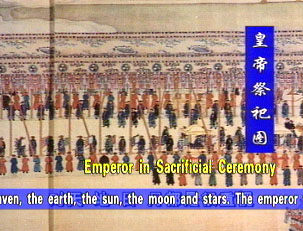 "The ancients said, 'The most important state affair is sacrifice and the most important sacrifice is to Heaven.' The ancient book Zuo Zhuan, or Zuo's Commentaries, also said, 'The first thing for the state is sacrifice and war.' This means the first thing is to worship Heaven," said Xu Zhichang, general engineer in the Heaven-Temple Park. "The ancients said, 'The most important state affair is sacrifice and the most important sacrifice is to Heaven.' The ancient book Zuo Zhuan, or Zuo's Commentaries, also said, 'The first thing for the state is sacrifice and war.' This means the first thing is to worship Heaven," said Xu Zhichang, general engineer in the Heaven-Temple Park.
"A temple of Heaven was indispensable in the planning of ancient Chinese cities. Because the 'son of Heaven', namely the emperor, reigned on behalf of Heaven. Besides, agriculture was the main part of Chinese civilisation, so Heaven was very important, because people lived at the mercy of the natural elements, or Heaven. People attached importance to Heaven, the earth, the sun, the moon and stars. The emperor would attend the sacrificial ceremonies in person," said Luo Zhewen, expert from the State Bureau of Historical Relics.
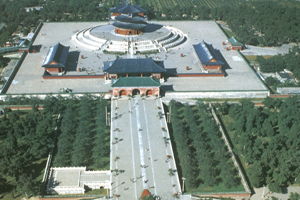 The Temple of Heaven covers 2,730,000 square metres, an area five times the Forbidden City. During the Ming and Qing dynasties it was the altar where the emperors prayed for good harvest in spring and offer sacrifice to Heaven in winter. It is the largest existent building complex for sacrificial purpose in China. The Temple of Heaven covers 2,730,000 square metres, an area five times the Forbidden City. During the Ming and Qing dynasties it was the altar where the emperors prayed for good harvest in spring and offer sacrifice to Heaven in winter. It is the largest existent building complex for sacrificial purpose in China.
The Temple of Heaven has two altars, the inner altar and the outer altar. The main buildings are in the inner part. The Circular Mound Altar in the south of the Temple of Heaven is also called the "altar to Heaven", the "altar to worship Heaven" and the "sacrificial altar". It is built all in stones. The top plane has no house on it, so that men can talk directly to Heaven. When the ancient people planned the Circular Mound Altar, with the round shape and the number of nine they merged their understanding of and veneration to Heaven into the construction.
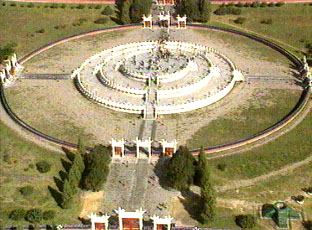 At the centre of the top of the Circular Mound Altar is a circular slab, which is the only one circular slab in the building complex. It is called the Stone of "Taiji" or the Stone of Supreme Being. Immediately around the Stone of Taiji are nine slabs in a circle, and around these nine is another circle of eighteen, and so on, each circle has nine slabs more than the adjoining inner one. All the circles are concentric and each has a multiple of nine. At the centre of the top of the Circular Mound Altar is a circular slab, which is the only one circular slab in the building complex. It is called the Stone of "Taiji" or the Stone of Supreme Being. Immediately around the Stone of Taiji are nine slabs in a circle, and around these nine is another circle of eighteen, and so on, each circle has nine slabs more than the adjoining inner one. All the circles are concentric and each has a multiple of nine.
"The number of nine has a special meaning. Heaven belongs to yang, and the earth belongs to yin. Yang is marked by an odd number and yin is marked by an even number. Nine is the largest (one-digit) odd number. So it is used to show the veneration to Heaven, the supreme being. That is its philosophical meaning. It is a rational suggestion," said Yang Xin, professor at the Department of Philosophy in Beijing University.
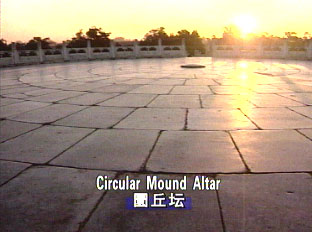 On the day of winter solstice, emperors would hold sacrificial ceremony to Heaven on the Circular Mound Altar. The altar was once a mystic sacrificial spot. But this means little to today's people. When people appreciate the elegance of the Temple of Heaven, what they feel is the auspicious and harmonious atmosphere that is unique of this place. On the day of winter solstice, emperors would hold sacrificial ceremony to Heaven on the Circular Mound Altar. The altar was once a mystic sacrificial spot. But this means little to today's people. When people appreciate the elegance of the Temple of Heaven, what they feel is the auspicious and harmonious atmosphere that is unique of this place.
Beijing has four sacrificial altars in its north, south, east and west. They are the Temple of Heaven, Altar of Earth, Altar of the Sun and Altar of the Moon. The Temple of Heaven situates in the south of the city. Its main buildings sit astride an axis running north and south.
Walking along the broad road from the Red Stairway Bridge or Danbi Bridge, you feel as if you are ascending Heaven. The Hall of Prayer for Good Harvest, where emperors used to pray for good harvest in spring, is at the northernmost end. This 38-metre circular hall stands on a three-storeyed marble base. The inside of the Hall is ornamented with splendid patterns of dragons and phoenixes gleaming in green and gold. The whole hall is in a wooden structure. It is a typical Chinese round building.
"The pillars, beams, rafters and coffer ceilings are joined by mortises and tenons. This means, so to speak, not a single iron nail is used. This is a pride of Chinese architecture. Its form is scientific. The large roof is not merely for good looking, but has its special function. It shields the building from rain. This type of architecture is called framing structure. All advanced buildings in modern and contemporary times are in framing structures," said Luo Zhewen, expert from the State Bureau of Historical Relics.
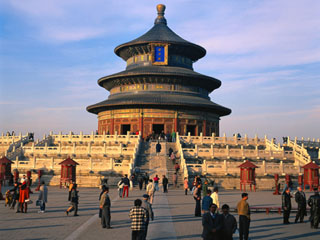 People say the four pillars in the innermost ring in the Hall of Prayer for Good Harvest symbolise the four seasons of the year, and the twelve pillars in the middle ring symbolise the twelve months of the year, and the twelve in the outer ring symbolise the twelve shichen of a day, each shichen equals two hours. The twenty four pillars in the middle and outer rings symbolise the twenty four solar terms of the year. The round spatial structure visually shows the chronological periodic cycle. Some people say the coffer ceiling with patterns of dragons and phoenixes corresponds to the slab with dragon and phoenix on centre of the ground. This symbolises the harmony between Heaven and earth. Everything in the Hall seems to display a subtle relationship between Man and Heaven. People say the four pillars in the innermost ring in the Hall of Prayer for Good Harvest symbolise the four seasons of the year, and the twelve pillars in the middle ring symbolise the twelve months of the year, and the twelve in the outer ring symbolise the twelve shichen of a day, each shichen equals two hours. The twenty four pillars in the middle and outer rings symbolise the twenty four solar terms of the year. The round spatial structure visually shows the chronological periodic cycle. Some people say the coffer ceiling with patterns of dragons and phoenixes corresponds to the slab with dragon and phoenix on centre of the ground. This symbolises the harmony between Heaven and earth. Everything in the Hall seems to display a subtle relationship between Man and Heaven.
The environmental plan of the Temple of Heaven is also enlightening for today's architects. To offset the high and wide Heaven, ancient architects used large areas of pines and cypress to set the red walls, blue roof tiles and white stairs in relief. Such successful planning provides a model of harmony between architecture and environment.
"Temple of Heaven not only records the evolution of our ideology and culture of thousands of years, but it encapsulates Chinese culture, architecture and art. So we can say it is a carrier of our ancient civilisation," said Xu Zhichang, general engineer at the Park of Temple of Heaven.
Standing on the axis of the Temple of Heaven, you will see the Hall of Prayer for Good Harvest in the north and the Circular Mound Altar in the south, one is high and other low, one is brilliant and the other light. They are in contrast to each other, and at the same time they are in harmony. The ingenuity of the construction of the Temple of Heaven is that it evokes infinite imagination by way of a finite architectural entity and it suggests the unity of human and nature.
|
|
|
|
|
|
|
 |









